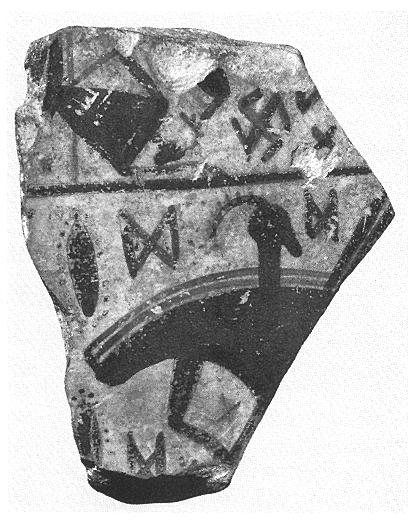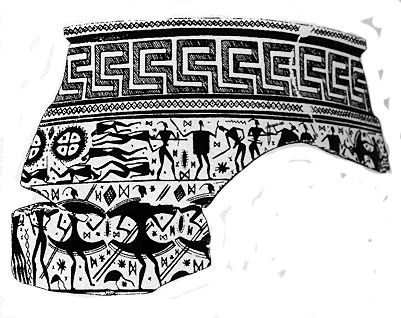
|

|
When I look at the ancient krater (wine mixing bowl) fragments from 760-750 B. C., I first conjure up Hollywood images from science fiction films like Stargate. The warrior, as extraterrestrial, has a massive body shield, ornate helmet, and spearlike weapon. Other icons on the pottery shard on the left also have a modern meaning. The fallen warrior (above left) dies it seems next to a swastika, a symbol that has horrific significance in the 20th Century; however, its meaning in ancient time remains mostly unknown.
Do these artistic images reflect ancient reality? Do they truly represent a culture that once existed? In answering this question we begin by dividing The Age of Homer into three different but distinct time periods known as The Three Ages of Homer. Long before the Iliad became a written text, the oral tradition (perpetuated by bards equipped with a lyre) extends backwards in time to at least the Greek Mycenaean Age (1550-1100 B. C.). Then a second period, mysteriously known as the Dark Age (1100-760 B. C.), begins (titled as such if only because scholars do not really know much about what happen during that time). We are left to surmise that the epic stories passed through the Dark Age and developed as they went, until they were written down in 760 B. C. by the equally mysterious author known as Homer. The argument goes something like this: a majority of people see the Trojan War as the story of Mycenaean culture which existed from 1550-1100 B. C. Book Two in the Iliad--"The Catalogue of Ships"-- is a late Mycenaean gazetteer in verse that was preserved virtually verbatim and inserted (rather awkwardly) into the epic (1). Others believe that the story reflects the lives of people living in The Dark Age, and still others argue that the Iliad reflects Homer's own present (760 B. C.). I favor a hypothesis offered by Jeffrey M. Hurwit: " Those who wish to locate "Homeric Society" firmly in this period or that will continue to have no trouble finding passages in the poems to support their cases. Nonetheless, attempts to use the Iliad and Odyssey as social history are in the end misguided. For the "Homeric World" is rooted not so much in any one period or even a combination of periods as it is a monumental and selective literary imagination." So some of the heroes in the Trojan War may have existed but the historicity of the war itself and its heroes remains controversial and, more than likely, the truth is grounded in the more ephemeral history of the human imagination.
Other things we should know: The third Age of Homer is associated with an era known as the Greek renaissance. The Greek alphabet certainly plays a role in designating this era as a "renaissance." We see for the first time a language where the utterances and sounds of the human voice are represented in written form, a technology (if you will) which the Greeks learned from the Phoenicians. This phonetic language is vastly different from the ideograms of cuneiform that tell the tale of King Gilgamesh. Homer lived in a world that was rapidly becoming literate. This literacy exists simultaneously with Geometric vases where human warriors appear with animals--horses, pigs, birds, deer (notice the birds at the feet of the warriors in the image on the right). Battles do occur. All this warfare is happening in a burgeoning urbanized yet agrarian world--the city / Sate or polis--where like-minded people establish a citadel, incorporating town and country as inseparable parts to a unit. This of course is strikingly similar to the final division of Uruk in the much older story The Epic of Gilgamesh. By the Age of Homer, political systems emerge that define human culture. The system includes certain phenomena--the hero, the temple, the war, the art, the contest.
The heroic image begins in this CONTEXT. The epic and the
geometric art define the age of heroes and shape the mythology
that tells us about our relationships with each other as members
of a structured and interdependent community.
Works Cited:
(1) Hurwit, Jeffrey M. "Art, Poetry, and the Polis in the Age of Homer" in From Pasture to Polis. Edited by Susan Langdon. University of Missouri Press: Columbia, 1993, pages 14-42.